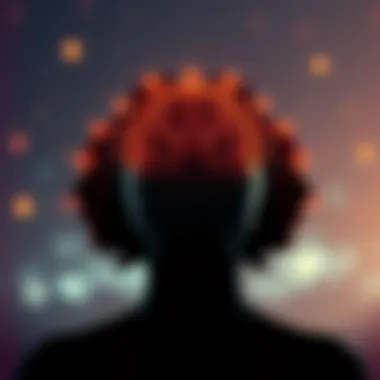Understanding the Complexities of Consciousness


Intro
The exploration of psychological states of consciousness is as vast as the human mind itself. Each individual experiences consciousness in multifaceted ways—be it while daydreaming in a lecture hall, slipping into deep sleep, or entering a meditative state. Each of these examples denotes varying levels of awareness and engagement with reality, raising the question: What truly defines our conscious experiences?
Psychologists and neuroscientists alike have probed these waters, trying to unravel the complexity of consciousness. Their investigations range from traditional viewpoints rooted in behaviorism to more contemporary explorations that include phenomena like altered states. As we step deeper into this realm, we can uncover not just how diverse these states are, but also the underlying mechanisms that govern them.
In this discourse, we will embark on a journey that aims to clarify the different states that lie within the conscious spectrum, the implications they hold for cognitive processes, and their profound impact on our overall well-being.
Through examining key theories—both scientific and experiential—we will gain insight into how these states intersect with our daily lives, influencing everything from decision-making to emotional regulation. This article seeks not only to inform but to stimulate curiosity in students, researchers, and anyone intrigued by the intricate workings of the mind.
It's essential to set the stage with a research overview as our primary focus, ensuring we gather both the findings and significance of this topic.
Preamble to States of Consciousness
Understanding the different states of consciousness is essential in the study of psychology. This exploration not only provides insights into how humans process information but also reveals deeper implications for mental health and cognitive functioning. Our consciousness shapes our reality, influencing perceptions, emotions, and behaviors. By unraveling these states, we can better grasp the complexities of the mind, tailoring approaches to education, therapy, and personal development.
An individual's state of consciousness affects their day-to-day functioning profoundly. For instance, when one is wide awake, thought processes are often linear and task-focused, while in a dream state, the mind wanders freely, often weaving together disparate ideas and images. These variations in consciousness not only form the basis of what we experience but also act as keys to understanding psychological disorders, cognitive development, and emotional regulation.
Moreover, exploring consciousness allows us to recognize the nuances that different states can bring about. It invites us to consider how altered states—whether through meditation, sleep, or substance use—can expand our awareness and, at times, offer insights inaccessible in the waking state. What this article aims to achieve is to delve into these fascinating layers of consciousness, outlining how they manifest in our lives and impact our understanding of the mind.
Key Insights:
- Consciousness shapes our reality, influencing perceptions and behavior.
- Different states can significantly impact cognitive functions and mental health.
- Exploration of altered states can yield insights into human experiences.
"Consciousness is the interface between mind and world, reflecting how we interpret our surroundings and our own thoughts."
In examining the states of consciousness, we embark on a journey through definitions, historical perspectives, types, and the psychological implications that arise from these varying states. By synthesizing research findings with experiential insights, this article aims to present a comprehensive examination tailored for students, researchers, and professionals alike—equipping readers with the knowledge to navigate this complex terrain of human cognition.
Types of Consciousness States
Understanding the different types of consciousness states is vital for anyone delving into the psychology of the mind. These states not only shape our daily experiences but also influence our overall mental well-being. Each state offers unique insights into human cognition and behavior. By exploring these types, we can better appreciate the complexity and richness of conscious experience, as well as the profound implications on health, cognition, and self-awareness.
Waking State
The waking state is the most familiar and widely experienced form of consciousness. During this state, individuals are engaged with their surroundings, processing information through their senses and engaging in tasks ranging from the mundane to the complex. Here, cognitive functions are at their peak; thoughts flow freely, and social interactions occur naturally. The ability to think critically and make decisions is heightened.
People in this state are also able to engage with reality, interpreting stimuli from the environment and responding accordingly. This engagement with the external world fosters learning and adaptation, making the waking state crucial for personal growth and development.
Sleep and Dream States
Sleep is often misunderstood as mere recovery time, but it is, in fact, a dynamic state of consciousness crucial for physical and mental health. The various stages of sleep, particularly REM (Rapid Eye Movement) sleep, allow not just for physical restoration but also for complex mental processes such as memory consolidation and emotional regulation. It is during these cycles of sleep that dreaming occurs, offering intriguing insights into the subconscious mind. Dreams can act as a canvas, painting vivid scenarios that reflect our thoughts, feelings, and unresolved issues.
Dreaming serves multiple purposes: it aids in problem-solving, enhances creativity, and even provides a space for emotional processing. Ignoring the significance of this state can lead to a reduction in cognitive functions over time, highlighting the importance of regular, quality sleep.
Altered States of Consciousness
Altered states of consciousness cover a broad spectrum of experiences that deviate from ordinary waking consciousness. These states can arise through various means, including substance use, meditation, or even spontaneous events like near-death experiences. Understanding these phenomena can deepen our grasp of both psychological and spiritual facets of human existence.
Substance-Induced States
Substance-induced states refer to alterations in consciousness brought on by the consumption of drugs or alcohol. These states can lead to heightened emotions, distorted perceptions of reality, and sometimes a sense of transcendence. Many individuals seek out these experiences for pleasure, exploration, or escape from daily life. The distinctive characteristic of substance-induced states is their capacity to rapidly alter cognitive and sensory perceptions. However, the convenience of accessing these states comes with risks.
While some users report moments of clarity or insight, the potential for addiction and negative health impacts looms large. Moreover, the experience can vary widely from one individual to another, which complicates its implications in both clinical contexts and recreational settings.
Meditative States
Meditative states present a fascinating contrast to substance-induced experiences. Often described as deep states of relaxation and heightened awareness, meditation offers a path toward mental clarity and inner peace without external substances. These states can facilitate a profound connection to one's thoughts and feelings, fostering mindfulness and emotional balance.
Individuals who practice meditation often report improved focus, reduced stress, and a greater sense of overall well-being. A key feature of meditative states is their natural accessibility, as virtually anyone can learn to meditate with practice. However, achieving this state requires dedication and training, and the benefits may not materialize overnight. Yet, for many, the journey itself is enriching, making meditation a worthwhile topic in the context of consciousness.
Near-Death Experiences
Near-death experiences (NDEs) offer one of the most compelling perspectives on altered states of consciousness. Reported by individuals who have come close to death or experienced significant trauma, these experiences often involve sensations of floating, moving through a tunnel, or encountering deceased loved ones. The implications of NDEs are far-reaching, sparking discussions about the nature of consciousness itself.
A notable characteristic of NDEs is that they often bring lasting changes in individuals’ perceptions of life and death, spurring reflections on spirituality and existence. The contemplative journey through an NDE can often lead to enhanced empathy and a profound appreciation for life, which showcases the transformative power of these encounters. However, the subjective nature of these experiences makes them challenging to study scientifically, thus adding an element of mystery around them.


The exploration of consciousness states not only uncovers the intricacies of the human mind but serves as a bridge into understanding the psychological and physiological mechanisms at play. Recognizing these states helps in addressing mental health issues and enhancing overall well-being.
Mechanisms Behind Consciousness
Understanding the mechanisms behind consciousness is not merely an academic exercise; it's a journey into the very fabric of what makes us human. This section examines the intricate interplay between our neurological frameworks and cognitive processes. By unpacking these components, we can glean insights that inform not just theoretical discourse but also practical applications in mental health, education, and beyond. The significance of comprehending how these mechanisms operate cannot be overstated, as it helps unravel the mysteries surrounding our subjective experiences where thoughts, feelings, and sensory impressions converge.
Neurological Underpinnings
When discussing consciousness, one cannot ignore the vital role played by our brain's structure and function. At the core of neurological underpinnings lies the brain itself, a highly complex organ composed of billions of neurons and synapses intricately wired together. Each neural connection is a potential gateway to an experience or a thought.
Here are key elements to consider:
- Neurotransmitters: Chemicals in the brain, like serotonin and dopamine, create pathways that influence our moods and perceptions. An imbalance can lead to varied states of consciousness, from blissful moments to depths of despair.
- Brain Regions: Specific areas like the prefrontal cortex, responsible for decision-making and self-awareness, are integral to higher-order consciousness states. The thalamus, often termed a relay station, channels sensory information to the cortex, marking the line between what we perceive and what slips into unconsciousness.
- Neuroplasticity: Our brains can evolve and adapt in response to experiences. This plasticity plays a crucial role in learning and memory, impacting how we assemble our conscious experiences.
Exploring these elements helps demystify the processes that underlie the states we inhabit daily. Each finding spirals into new questions and avenues of research that propel our understanding… and sometimes raise even more questions.
Cognitive Processes Involved
Moving beyond the neurological, we land on the cognitive processes that often feel like the icing on the cake of consciousness. These processes reveal how we interpret the world around us and make sense of our internal experiences. The focus here is on how perception, memory, and attention thread together the tapestry of consciousness.
- Perception: Our senses—sight, sound, touch, taste, and smell—demand immediate attention. The brain continuously processes vast amounts of sensory data, highlighting what's relevant and filtering out the noise. This balancing act shapes our conscious experience and influences our thoughts and reactions to various stimuli.
- Attention: Think of attention as a spotlight that allows certain thoughts or objects to shine brighter in our conscious awareness while dimming others. The mechanisms behind attention can significantly impact how we experience reality. Multitasking, for instance, may create a fragmented consciousness where full engagement becomes an elusive target.
- Memory: Our past shapes our present. Memory not only records experiences but also influences our current thoughts and feelings. This cognitive process generates a rich, layered consciousness, where past experiences interlace with the present moment, coloring our perceptions and expectations.
Studying these cognitive processes reveals that consciousness is far more than passive observation; it is an active engagement with our environment, colored by our history and intentions.
By diving deep into the neurological and cognitive underpinnings of consciousness, we unlock a treasure trove of knowledge that can transform how we view mental well-being, learning environments, and even relationships. The interplay between these elements crafts a more comprehensive understanding of who we are and how we engage with the world, making the human experience infinitely nuanced and profoundly intriguing.
Theories of Consciousness
The field of consciousness studies encompasses a variety of theories that attempt to explain what consciousness actually is and how it functions. Understanding these theories is vital for grasping the complexities of human cognition and perception and scrutinizing the relationship between mental states and the physical brain. Each theory elucidates different aspects of consciousness, addressing questions about awareness, perception, and thought processes. By examining these frameworks, we can better appreciate the intricate workings of the mind, providing insights applicable to psychology, neuroscience, and even philosophy.
Global Workspace Theory
Global Workspace Theory (GWT), primarily formulated by Bernard Baars, posits that consciousness functions as a "workspace" where information is processed and made accessible to various cognitive processes. According to this theory, consciousness is not a singular entity but a collaborative effort of numerous unconscious processes that compete for attention. This theory explains how specific information reaches the forefront of our awareness, while countless other data remains in the background.
- Key Points:
- GWT explains why only a small fraction of our thought processes enter conscious awareness.
- It emphasizes the role of attention as a spotlight that selects which information is brought into consciousness.
For instance, when solving a complex problem, your brain may juggle various ideas and possible solutions, but only one can emerge as the primary focus. That selected idea is what you consciously process, while the rest remain on the back burner. This perspective has profound implications for understanding topics like memory, attention, and even psychopathology—for instance, highlighting how some traumas may affect what enters our conscious awareness.
Integrated Information Theory
Integrated Information Theory (IIT) takes a different approach, offering a measure of consciousness based on the integration of information within a system. Developed by Giulio Tononi, this theory holds that consciousness corresponds to the capacity of a system to integrate information in a unified experience. In simpler terms, the more integrated the information is, the richer the conscious experience. The theory proposes a mathematical framework to quantify this integration and assesses the degree of consciousness based on connectedness among its elements.
- Key Points:
- IIT quantifies consciousness through a concept known as Phi (Φ), which measures the amount of integrated information.
- This theory allows for the possibility that consciousness could exist in non-human entities, provided they exhibit sufficient integrated information.
For example, consider a complex neural network. If it exhibits high Phi, we might conclude it has more integrated experiences—suggesting a richer type of consciousness—in comparison to a simpler organism. This raises intriguing questions about the nature of consciousness across species and computational systems, introducing philosophical dilemmas regarding artificial intelligence and its potential consciousness.
Higher-Order Thought Theories
Higher-Order Thought (HOT) Theories propose that consciousness arises from our thoughts about our own mental states. According to this viewpoint, an individual becomes conscious of a thought only when they have a higher-order thought about that first-order thought. In essence, consciousness includes both the content of our thoughts and our awareness of those thoughts. This view implies that being conscious of one's thoughts elevates our cognitive process, making introspection a key characteristic of conscious awareness.
- Key Points:
- HOT theorists argue that consciousness is inherently linked to self-reflection and metacognition.
- It provides a framework for understanding disorders like schizophrenia, where self-awareness may become distorted.
To illustrate, when you are aware that you are thinking about your past experiences, you take a step back and analyze those thoughts. This ability to reflect elevates the basic act of thought into a conscious experience. However, it challenges us to consider how individuals with impairments in self-awareness navigate their understanding of reality—be it due to cognitive decline or certain psychopathologies.
Understanding these theories provides invaluable insight into consciousness and its myriad forms. It not only challenges us to reevaluate our definitions of consciousness but also propels the scientific community to expand its horizons in understanding the mind.
In essence, the study of these theories enables us to dissect consciousness at its core, unveiling the interwoven threads connecting cognition, perception, and mental health.
Psychological Impact of Consciousness States
Understanding the psychological impact of various states of consciousness is vital for a multitude of reasons. Each state—whether it be waking, dreaming, meditative, or otherwise—shapes our thoughts, behaviors, and overall well-being. These impacts can be both profound and subtle, influencing not just individual experiences but also collective societal patterns. Recognizing how these states affect mental health, alter cognition and perception, and facilitate emotional regulation is essential for promoting overall psychological wellness.
The psychological landscape is intricate, interwoven with the rise and fall of consciousness as we navigate daily life. Through exploring these connections, we can uncover strategies to enhance mental resilience, foster emotional growth, and improve cognitive function. Moreover, these insights offer potential pathways for therapeutic practices, essential for individuals grappling with various psychological disorders.


Effects on Mental Health
The relationship between states of consciousness and mental health is complex and multifaceted. For example, research indicates that individuals who maintain good sleep hygiene and experience restorative sleep often report better mood and reduced anxiety levels. On the other hand, chronic sleep deprivation can lead to increased irritability, depression, and cognitive decline. Here are several salient points to consider:
- Quality of Sleep: Deep sleep promotes the release of hormones such as growth hormone, crucial for both physical and mental restoration.
- Mindfulness and Presence: Engaging in mindfulness practices has demonstrated success in reducing symptoms of anxiety and depression. Being fully present can foster a sense of control over one’s thoughts and surroundings.
- Substance Use: The conscious choice to use certain substances can bring about altered states of mind, often leading to both temporary euphoria and possible long-term mental health consequences.
"Consciousness is not a thing, but a continuum. It ebbs and flows, shapes our mental health profoundly, and reflects our undoing or redemption."
Cognition and Perception
States of consciousness heavily influence how we process information and interpret the world around us. An individual in a heightened state of awareness—like during a meditation retreat—may experience enhanced focus and clarity arising from the absence of distractions. Conversely, when one faces fatigue or distraction, cognitive task performance might diminish sharply.
Some critical aspects include:
- Attention and Focus: Varied states of consciousness dictate the levels of attention we can muster. A clear mind can lead to improved analytical thinking, enabling a person to tackle complex problems effectively.
- Perceptual Filters: How we perceive stimuli—whether filtering out noise or amplifying certain sounds—changes with our consciousness. An artist or musician in a creative state might hear nuances that pass unnoticed by others.
- Decision Making: Studies suggest that altered states, such as those experienced during flow or immersive experiences, can lead to quicker yet more intuitive decision-making processes.
Emotional Regulation
Emotional regulation is another realm significantly influenced by states of consciousness. It refers to our ability to manage and respond to emotional experiences in a healthful manner. Conscious awareness allows individuals to recognize their emotional states and practice techniques to modulate them effectively.
Some elements worth noting include:
- Awareness and Acknowledgment: When in a meditative state, individuals may find it easier to acknowledge uncomfortable emotions without immediate reactivity, fostering a responsive instead of reactive approach.
- Therapeutic Modalities: Techniques such as cognitive behavioral therapy draw upon an understanding of consciousness to help individuals learn how to reframe thoughts and effectively manage their emotional responses.
- Resilience Building: Regularly engaging with altered states, like mindfulness or reflective meditation, can promote resilience against emotional upheavals, making it easier for individuals to navigate stressors in daily life.
The implications of understanding these components are far-reaching. As we dissect the psychological impacts of the states of consciousness, we create opportunities for enhancing mental health, promoting deeper cognitive engagement, and learning effective emotional regulation skills—all essential for living a balanced, fulfilling life.
Cultural Perspectives on Consciousness
Understanding consciousness is not only a scientific endeavor but also a profoundly cultural one. Various cultures around the world interpret the nature of consciousness uniquely, shaped by historical, social, and spiritual contexts. This exploration sheds light on how different societal frameworks color our understandings and experiences of consciousness, influencing both individual perceptions and collective paradigms.
Cultural perspectives offer several benefits to our understanding of consciousness. For example, they can help contextualize experiences of altered states, reveal biases within dominant psychological theories, and encourage more inclusive models of cognition that respect diverse perspectives. Considerations include recognizing how cultural background can affect subjective experiences of consciousness and mental states. It begs the question: how do people from various traditions view consciousness, and what implications does that hold for education, psychotherapy, and mental health approaches globally?
Different Cultural Interpretations
Different cultures have distinct interpretations of consciousness, leading to a rich tapestry of concepts and beliefs. In many Eastern traditions, for instance, consciousness is often seen as interconnected rather than an isolated individual phenomenon. This perspective can be observed in philosophies such as Buddhism and Hinduism, where the nature of self is often viewed as an illusion or 'Maya.' Such viewpoints emphasize the importance of collective awareness and mindfulness.
In contrast, Western philosophies tend to place more emphasis on individual consciousness, intervening in the environment as separate entities. For instance, Cartesian dualism – the idea that mind and body are separate – has dominated Western thought, affecting psychology and neuroscience for centuries.
This divergence in perspectives is crucial for understanding how various mindsets influence mental health practices.
- Example: In a study by the American Psychological Association, it was noted that individuals from collectivist societies may prioritize family and community values during therapeutic processes, which contrasts with individualistic frameworks commonly found in Western cultures.
Spiritual and Religious Dimensions
Spiritual and religious dimensions add another layer to our understanding of consciousness. Cultures incorporate spiritual beliefs and practices, which can deeply influence how individuals perceive their own consciousness. In many indigenous cultures, spiritual journeys and rites of passage involving altered states are viewed as essential for understanding one’s place in the universe and connecting with a higher power.
For example, in Shamanistic practices, a shaman may enter altered states of consciousness to gain insights or healing for members of their community. This practice is not viewed through the lens of traditional psychology but rather as a vital aspect of the understanding of self. In this context, consciousness is a bridge to the spiritual realm, where wisdom is sought and gained.
To illustrate, a prominent study by the Journal of Consciousness Studies highlights the contrast in how various faiths interpret the afterlife, influencing people's living beliefs and experiences of consciousness.
The interplay between consciousness and spirituality is a compelling area of research, suggesting that our understanding of consciousness could be enriched by embracing these diverse cultural narratives.
As we step into a globally connected future, the examination of consciousness through varied cultural lenses will not only enhance therapeutic practices but also deepen our grasp of what it means to be human. Understanding these cultural interpretations fosters a more holistic approach to consciousness, allowing for richer discussions that could bridge gaps between science and spirituality while respecting cultural sensitivities.
By truly understanding these perspectives, mental health professionals, educators, and researchers can become more culturally competent, tailoring their approaches to fit the diverse needs of clients and communities. This comprehensive view on consciousness is crucial for everyone engaged in the science and application of psychology.
Alterations in Consciousness
The exploration of alterations in consciousness reveals insights into how different states can affect human experience, relationships, and overall psychological health. Whether induced by pharmacological substances or achieved through meditation practices, these altered states provide a fascinating perspective into the workings of the mind. Understanding these changes is crucial because it opens up discussions about techniques that can enhance well-being and cognitive function. Compounding effects from various alterations can lead to therapeutic breakthroughs, recognizing the potential benefits and risks involved in these states.
Pharmacological Influences
Pharmacological alterations of consciousness are often the most discussed aspects in studies addressing substance use. Various substances can induce significant changes in perception, emotion, and cognition. From caffeine—an everyday stimulant—to more complex substances like psilocybin, the range of effects is vast.
- Stimulants: Substances like coffee can increase alertness and energy, often enhancing focus but occasionally leading to heightened anxiety.
- Hallucinogens: On the other hand, substances such as LSD or magic mushrooms can radically alter perception, producing experiences that some describe as life-changing. It's vital to approach these substances with caution due to their unpredictable nature.
- Depressants: Alcohol and medications like benzodiazepines can suppress the central nervous system, affecting cognition and decisions, often at the expense of mental clarity.
"The challenge with pharmacological influences lies in balancing the beneficial effects against the risks of dependency and adverse reactions."
Meditation and Mindfulness


Meditation and mindfulness practices represent a different avenue for altering consciousness, devoid of chemical intervention. They emphasize the innate ability to shift one’s state of awareness through intentional focus and breathing techniques. These practices have seen a rise in popularity due to their mental health benefits, which have been recognized not just in holistic circles but increasingly within mainstream psychology.
Some key benefits include:
- Stress Reduction: Regular mindfulness practice is associated with decreased levels of cortisol, the stress hormone, leading to improved emotional outcomes.
- Enhanced Focus: Training the mind to maintain attention has shown potential in boosting cognitive function, enabling clearer thinking and increased productivity.
- Emotional Regulation: Becoming aware of one’s thoughts and emotions can decrease impulsivity, offering tools to manage reactions more effectively.
Incorporating meditation into daily routines can promote a healthier mental state, emphasizing the importance of consistent practice.
These forms of consciousness alteration offer rich resources for both academic exploration and practical application, making them vital for the understanding of human psychology.
Clinical Applications of Understanding Consciousness
The topic of clinical applications concerning consciousness is not merely about theories; it drives home the practical implications that psychology can wield in addressing mental health issues. By exploring different states of consciousness, clinicians can devise more effective therapeutic approaches tailored to individual needs, helping people deal with various disorders. Grasping consciousness in its many forms allows for a nuanced understanding of mental health, guiding professional practices and ultimately improving patient outcomes.
Therapeutic Techniques
Therapeutic techniques that arise from understanding consciousness can take various forms, each tailored to engage different states of cognitive functioning. Some prominent methods include:
- Cognitive Behavioral Therapy (CBT): This approach hones in on the interplay between thought patterns and emotional states. By modulating disturbances in conscious thought, CBT empowers individuals to alter negative thinking and behavior.
- Mindfulness-Based Stress Reduction (MBSR): Here, practitioners encourage individuals to enter a state of heightened awareness, allowing for increased observation of thoughts without judgment. This can lead to reduced anxiety and stress by breaking habitual thought patterns.
- Eye Movement Desensitization and Reprocessing (EMDR): Often employed for trauma treatment, EMDR taps into altered states of consciousness to help clients process distressing memories. The practice looks to integrate these memories into the broader fabric of consciousness.
- Psychoanalytic Techniques: By addressing unconscious processes, the therapeutic dialogue facilitates greater insight into different states of consciousness. This dialogue involves exploring dreams, feelings, and unchecked impulses, which enhances self-awareness.
These therapeutic techniques showcase the pragmatic side of understanding consciousness, as practitioners can build frameworks around which therapies can be constructed.
Research in Disorders of Consciousness
The realm of disorders of consciousness presents vital intersections between clinical practice and the study of human awareness. Disorders such as comas, vegetative states, and minimally conscious states prompt an urgent need for research that can influence clinical responses. Here are significant aspects worth noting:
- Neuroimaging Advances: Developing technologies like functional MRI (fMRI) and EEG have become invaluable. These tools allow researchers to visualize brain activity in individuals with consciousness disorders, exploring whether they retain any level of awareness.
- Ethical Considerations: Understanding consciousness also raises ethical questions in treating patients with severe disorders. Decisions around life support or intervention can heavily weigh on how one interprets consciousness.
- Rehabilitation Approaches: Insights gleaned from these studies can lead to more targeted rehabilitation methods. For instance, tailoring sensory stimuli based on an individual's residual awareness can aid in improving recovery outcomes.
In summary, the clinical applications of understanding consciousness are vast and multilayered. From therapeutic techniques that enhance mental well-being to focused research unraveling the mysteries of disorders of consciousness, it all constitutes an integral aspect of modern psychological practice. As the field continues to evolve, these applications will inevitably contribute significantly to the future of mental health care.
Future Directions in Consciousness Research
The exploration of consciousness is a continuously evolving field, ripe with potential for discovery and innovation. As psychological and neuroscientific research pushes boundaries, understanding consciousness is becoming more crucial to address various existential queries and practical applications. Each new revelation paves the way for a deeper comprehension of how consciousness affects our lives, making future research directions particularly relevant. By focusing on technological advances and interdisciplinary approaches, we set the stage for a future rich in insights and applications.
Technological Advances
The role of technology in the study of consciousness cannot be overstated. Innovations in imaging techniques and computational simulations are expanding the horizons of consciousness research. For instance, tools such as functional Magnetic Resonance Imaging (fMRI) and Electroencephalography (EEG) are providing unprecedented views into brain activity, making it possible to observe various states of consciousness in real-time. Such advancements help researchers identify the complexities of the neural correlates of consciousness.
Moreover, the advent of machine learning algorithms allows for the analysis of vast datasets from neuroimaging studies, revealing patterns that were once obscured. Here are a few key aspects of technological advances in this area:
- Enhanced Imaging Techniques: With the advent of new imaging technologies, such as high-resolution fMRI, researchers can now pinpoint the specific brain regions involved in different conscious states.
- AI in Neuropsychology: Artificial intelligence is not just a tool for data analysis; it's also becoming a partner in the study of consciousness itself, opening doors to novel interpretations of mental states.
- Neurofeedback Devices: Emerging technologies, like neurofeedback, allow individuals to modulate their brain states consciously, showcasing the practical implications of understanding consciousness on self-regulation and mental health.
These technological strides hold promise not only for academic inquiry but also for therapeutic applications. As brain-machine interfaces develop further, practical applications may arise to assist individuals with disorders of consciousness. This paves the way to a more inclusive understanding of consciousness that transcends traditional boundaries.
"Technological advancements promise a new era in the understanding of consciousness, one where our limitations may no longer define us.”
Interdisciplinary Approaches
The future of consciousness research also leans heavily on interdisciplinary approaches. Psychologists, neuroscientists, philosophers, and even artists are coming together to form a comprehensive perspective on this multifaceted subject. Each discipline brings distinct methodologies and insights, leading to a fuller understanding of consciousness.
- Cognitive Science Collaborations: Combining insights from psychology and neuroscience, cognitive scientists aim to untangle complex cognitive processes involved in consciousness. Here, collaboration fosters richer experimental designs that can probe the depths of subjective experience.
- Philosophy of Mind: Work from philosophical angles also contributes to the debate about the nature of consciousness. These discussions question fundamental assumptions and provoke thought about the ethical implications of consciousness research, sparking new ideas for empirical studies.
- Art and Consciousness: Surprisingly, the intersection of art and consciousness has gained traction. Artists’ interpretations of consciousness can reveal societal perceptions, highlighting how collective human experience shapes our understanding.
This melding of disciplines cultivates a fertile ground for new ideas and exploration, making the study of consciousness not just a scientific endeavor but a cultural one too. It reflects a broader trend in research where answers to complex questions often lie at the crossroads of varied fields.
As we look towards the future, the pathways illuminated by technological advances and interdisciplinary collaborations provide a promising landscape for understanding consciousness in its many forms. Engaging with these new directions can help unlock the mysteries of not just what it means to be conscious, but also how we may enhance and protect this elusive state.
Culmination
The examination of states of consciousness wraps up a journey through the complex landscape of human psychology. This discussion has illuminated the diverse types of consciousness, the mechanisms driving them, and the profound implications they hold for individuals and societies as a whole. Understanding consciousness is not just an academic pursuit; it's an endeavor that connects deeply with our everyday lives and experiences.
Summarizing Key Insights
Throughout this article, we've explored various realms of consciousness, from the clarity of the waking state to the elusive nature of dreams and altered states. Each of these states offers a unique lens through which to view human experience.
- Types of Consciousness: the article spanned the waking state, sleep, and altered states, highlighting how each impacts cognition and emotion.
- Mechanisms Behind Consciousness: We discussed the neurological and cognitive frameworks, emphasizing how they contribute to our understanding of consciousness.
- Theories in Consciousness: Theoretical perspectives, including Global Workspace Theory and Integrated Information Theory, provided insight into how consciousness might be constructed and understood.
- Psychological Impact: The article highlighted effects on mental health and our emotional lives, showing the intertwined nature of consciousness and psychological well-being.
To encapsulate these insights, it is clear that consciousness is multi-layered, reflecting not only individual cognitive processes but also societal norms, cultural frameworks, and even spiritual beliefs. This interconnectedness emphasizes the importance of continued exploration in this field.
Implications for Society
Understanding consciousness also carries significant implications for society. Grasping how different states of consciousness affect our behavior and interactions can pave the way for advancements in various domains, including mental health, education, and social policies.
- Mental Health Treatments: Insights into altered states, like those experienced during meditation or through substances, can lead to innovative therapeutic approaches, alleviating challenges such as anxiety and depression.
- Enhancing Education: Knowing how students engage with different states of consciousness could influence pedagogical strategies, helping educators to facilitate better focus and learning retention.
- Cultural Sensitivity: Acknowledging the varied perceptions of consciousness across cultures fosters mutual respect and understanding, contributing to more harmonious societies.
In sum, the exploration of consciousness is not an isolated endeavor but one that resonates through our societal fabric. It poses questions about identity, humanity, and the shared experiences we all navigate, reminding us we are not only striving for individual understanding but also for collective awareness.

